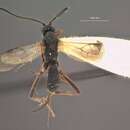Distribution
provided by Catalog of Hymenoptera in America North of Mexico
Calif.
- bibliographic citation
- Catalog of Hymenoptera in America North of Mexico. 1979. Prepared cooperatively by specialists on the various groups of Hymenoptera under the direction of Karl V. Krombein and Paul D. Hurd, Jr., Smithsonian Institution, and David R. Smith and B. D. Burks, Systematic Entomology Laboratory, Insect Identification and Beneficial Insect Introduction Institute. Science and Education Administration, United States Department of Agriculture.
Comprehensive Description
provided by Smithsonian Contributions to Zoology
Orgilus cristatus
Although very similar to lunaris, new species, this form may be readily distinguished by the presence of a short but high, median longitudinal keel at the base of the propodeum, by its closely sculptured and dull cheeks and by its black tegulae.
FEMALE.—Length about 4.4 mm. Head hardly wider than thorax at tegulae, in dorsal view fully 0.7 as long as wide and strongly excavated behind; face about 1.15 times as wide as eye height, closely rugulose punctate; clypeus very strongly convex and closely punctate; malar space barely longer than clypeus, about 0.45 as long as eye height, and finely granulose and dull; cheeks entirely granulose and dull; temples very nearly as wide as eyes, flat, barely receding, and broadly shagreened along occipital carina although smooth and shiny adjacent to eyes; occipital carina very prominent at the sides; ocellocular line less than twice as long as diameter of an ocellus; antennae of holotype incomplete, 29 segments remaining, segments 20–25 fully as broad as long.
Thorax stout; mesoscutum smooth and shiny, the middle lobe with very shallow but closely placed punctures anteriorly; notauli finely foveolate, meeting in a strongly rugulose triangular area at apex of scutum; prescutellar sulcus very broad and deep and strongly foveate; disc of scutellum convex, smooth and shining; propodeum coarsely rugose, and with a short but very prominent median longitudinal keel at base, the stubs of the apical carinae prominent and extending more than one-third the distance toward base of propodeum; side of pronotum finely rugulose in the impression, rather broadly smooth at upper margin and finely granulose on a small area at anterior margin; mesopleuron smooth and polished, the longitudinal furrow nearly straight and completely finely foveolate; metapleuron rugose on lower half, smooth and shiny above in the basal angle. Hind coxa half as long as hind femur, rugulose on upper edge and on upper part of outer side, smooth below; hind femur 5.5 times as long as wide; inner calcarium of hind tibia fully half as long as metatarsus; tarsal claws simple. Stigma about as long as radial cell on wing margin, very narrow, much narrower than length of first abscissa of radius; second abscissa of radius on a line with intercubitus; stub of third abscissa of cubitus as long as second abscissa; nervulus postfurcal by about one-third its length; hind wing not more than four times as long as wide; lower abscissa of basella hardly as long as nervellus and only one-third as long as mediella.
Abdomen a little narrower than thorax; first tergite about 1.2 times as long as wide at apex, closely longitudinally rugulose, the dorsal keels weak but distinct to beyond spiracles; second tergite large, as long as broad at base and closely, finely longitudinally rugulose except narrowly at apex where it is smooth; second suture fine but sharply impressed; third tergite largely smooth and polished but with a small, finely rugulose area on the basal middle; remainder of abdomen smooth and polished, the segments after the fourth almost completely retracted; ovipositor sheath nearly or quite as long as propodeum and abdomen combined.
Black; clypeus and palpi black; mandibles reddish; antennae black, the flagellum a little brownish on the underside toward base; tegulae black, wing bases piceous; wings distinctly infumated, rather more strongly so apically than basally; fore- and middle coxae yellowish brown; hind coxae black, brownish at apices; basal trochanters of all legs darkened, also the upper edges of the fore- and middle femora and the hind femora on the inner side; hind tibiae apically and all tarsi more or less darkened; abdomen completely black above and below.
MALE.—Unknown.
HOLOTYPE.—USNM 70156.
DISTRIBUTION.—Known only from the holotype female, which was taken at Sagehen Creek, near Hobart Mills, Nevada County, California, 16 July 1964, by M. E. Irwin.
- bibliographic citation
- Muesebeck, Carl F. W. 1970. "The Nearctic species of Orgilus Haliday (Hymenoptera: Braconidae)." Smithsonian Contributions to Zoology. 1-104. https://doi.org/10.5479/si.00810282.30

